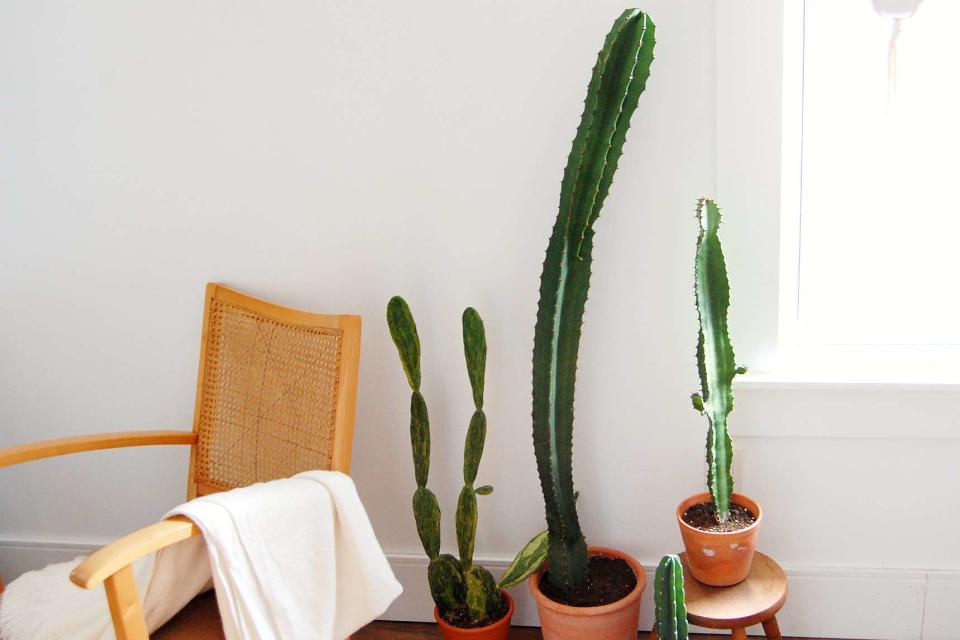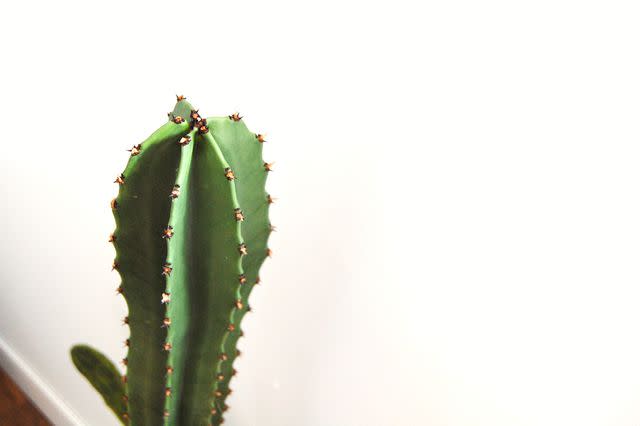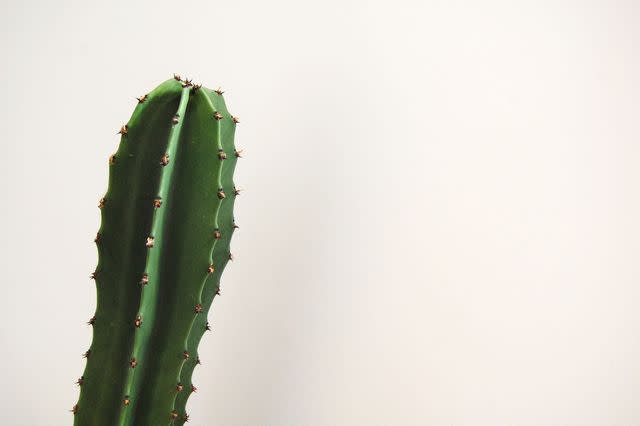How to Grow and Care for Euphorbia Ingens
These large succulents can grow indoors and outdoors.

The Spruce / Cori Sears
Reviewed by Kathleen Miller
Euphorbia ingens are large, tree-like succulents that are beloved for their stately appearance and low-maintenance nature. They are characterized by dark green, four-lobed stems and a columnar growth structure that branches as they mature — leading to the common nicknames candelabra cactus and African candelabra tree.
As with many other plants in the Euphorbia genus, the Euphorbia ingens grows well both indoors and outdoors and has become a popular choice for rock gardens and indoor houseplant collections alike. In their natural environment, these succulents can grow up to 40 feet tall, but they usually top out at around 8 to 10 feet tall when grown indoors. Euphorbia ingens flower during the fall and winter months. However, when grown indoors or in containers it is extremely uncommon for these euphorbia to produce blooms. Growers should exercise caution when handling this succulent tree as the milky latex sap of the Euphorbia ingens is considered extremely toxic to humans and pets.
Common Name | Candelabra cactus, African candelabra tree |
Botanical Name | Euphorbia ingens |
Family | Euphorbiaceae |
Plant Type | Succulent, tree |
Mature Size | 40 ft. tall (outdoors), 8-10 ft. tall (indoors), 5-15 ft. wide (outdoors), 15 in. wide (indoors) |
Sun Exposure | Full |
Soil Type | Sandy, well-draining |
Soil pH | Acidic, neutral |
Bloom Time | Fall, winter |
Flower Color | Yellow, green |
Hardiness Zones | 10-11 (USDA) |
Native Area | Africa |
Toxicity | Toxic to humans, toxic to pets |
Euphorbia Ingens Care
Euphorbia ingens are considered fairly low-maintenance succulents. Here is how to care for them:
Plant in a bright, sunny location.
Prefers sandy, well-draining soil.
Grow best in warm, dry conditions.
Are hardy, drought-tolerant plants that are not particularly fussy when it comes to fertilizing.

The Spruce / Cori Sears

The Spruce / Cori Sears
Light
These succulents require plenty of sunlight in order to thrive. A location that receives several hours of bright, direct light is best although they can tolerate medium light as well. Like many succulents, Euphorbia ingens cannot tolerate low light.
Soil
A sandy, well-draining soil mix is best for Euphorbia ingens. They are not picky when it comes to soil pH and grow readily in poor-quality soils. Choose a potting mix that is designed for cacti and succulents or mix your own at home using a 1:1 ratio of potting soil, perlite, and sand.
Water
Euphorbia ingens are accustomed to dry, arid conditions and can tolerate periods of drought. In fact, overwatering is one of the most common reasons that these succulents suffer when grown in garden beds or indoors as a houseplant. Ensure that you are letting the soil dry out between waterings and then water thoroughly. Providing your Euphorbia ingens with adequate drainage (in the form of soil and/or a container with drainage holes) is key to preventing overwatering.
Temperature and Humidity
Native to regions across Southern Africa, Euphorbia ingens prefer warm, dry conditions. This makes them particularly well-suited to indoor growing which has made them popular houseplants. Ideally, these plants should be kept in temperatures above 74 degrees Fahrenheit (23 degrees Celsius) but they can survive for short periods in temperatures as low as 28 degrees Fahrenheit (-2 degrees Celsius). Consequently, they can be grown outdoors year-round in USDA zones 10 through 11. Growers outside of these regions can grow Euphorbia ingens indoors year-round or in containers so that the plants can be overwintered indoors.
Fertilizer
These succulents are accustomed to growing in sandy, poor-quality soils and are not considered heavy feeders. In fact, over-fertilization can be a problem for Euphorbia ingens as they can easily suffer from fertilizer burn. If desired, a low-strength fertilizer designed for cacti and succulents can be applied in the spring and summer months to encourage strong, healthy growth although it is not necessary.
Pruning
Pruning and cutting Euphorbia ingens will cause the plant to branch and should be done during warmer temperatures so it can heal over the winter. Since the sap is toxic, be sure to wear safety goggles and thick gloves when handling the plant.
Propagating Euphorbia Ingens
While Euphorbia ingens can be grown from seed, the process can be tricky and seeds can be hard to come by. For that reason, these succulents are most commonly propagated by rooting stem cuttings, which is far more reliable. Regularly taking cuttings from your plant will also encourage a fuller appearance as the stems will branch wherever they are pruned.
Before you begin taking cuttings, it is important to take measures to protect yourself and your surroundings from the plant’s sap which can cause irritation if it comes into contact with the skin. Ensure that you use a pair of protective garden gloves and set something underneath your plant to protect the floor from dripping sap. To propagate Euphorbia ingens by stem cuttings, follow these steps.
Using a sharp, sterilized knife or pair of pruning shears, take a stem cutting from a healthy Euphorbia ingens plant. Use a paper towel to clean up any dripping sap from the cutting and the pruned edge of your plant.
Set the stem cutting in a shallow dish and set it aside to allow the cut end to callus over for at least 24 hours.
Prepare a small pot with a sandy, well-draining potting mix and plant the stem cutting in the soil. Pat the soil down firmly around the cutting so it stands up unsupported.
Place the potted cutting in a bright, sunny location. Do not water the cutting for at least 2 weeks. This is super important—without any roots to absorb moisture, watering the cutting too early can cause it to rot and die. After 2 weeks you can begin checking the cutting for roots by gently tugging on it to see if it is secured to the soil at all.
Once roots have begun to grow you can start watering the cutting regularly as you would with a mature plant.
Potting and Repotting Euphorbia Ingens
Euphorbia ingens should be repotted every couple of years in the spring or summer months. Roots growing from the pot’s drainage holes or circling the top of the pot are both indications that it is time to repot this succulent.
Choose a pot that is a couple of inches larger than its previous container and ensure you have some fresh potting soil. Remove the plant from its pot and loosen the root ball slightly before placing it in its new pot. Add the fresh soil around the plant’s roots and pat it down firmly around the base of the plant to secure it in place. After repotting, return your Euphorbia ingens to its previous location and resume its regular watering schedule.
Common Pests & Plant Diseases
There are a few common pests and plant diseases to keep an eye out for when growing Euphorbia ingens. Most notably, these desert succulents are prone to root rot if they are overwatered or exposed to moist conditions for a prolonged period of time. Unfortunately, the early stages of root rot can be hard to detect in these cacti, and usually once it becomes clear that something is wrong it is too late to save the plant. The best way to protect against root rot is to ensure that your plant has plenty of sunlight and is drying out thoroughly between waterings. In addition to root rot, keep an eye out for common pests like mealybugs, spider mites, and aphids.
Common Problems With Euphorbia Ingens
For the most part Euphorbia ingens are fairly low-maintenance and problem-free. The most common issues encountered when growing these succulents usually arise from improper watering.
Yellowing Stems
Yellow stems are a sign that your Euphorbia ingens is underwatered. Gradually increasing the frequency of watering should help to resolve this issue and prevent further yellowing, although stems that are already yellow may not recover fully. Remember that these succulents usually need more frequent watering in the spring and summer than they do in the fall and winter. Don’t forget to adjust your watering accordingly.
Mushy Stems
A Euphorbia ingens with mushy stems almost certainly has root rot. It is important to act quickly as soon as you notice your plant has a mushy stem as root rot moves fast and can kill these succulents quickly. The best way to save a Euphorbia ingens that is suffering from root rot is to cut the stem off above the rot and root the cutting in fresh soil. Follow the propagation steps to root the stem cutting.
Frequently Asked Questions
How fast do Euphorbia ingens grow?
These succulents are relatively fast-growing and can grow into sizable plants within just a few years. However, even under ideal conditions, it takes at least 10 to 20 years for them to reach their mature height.
Is Euphorbia ingens a cactus?
While Euphorbia ingens are commonly referred to as cacti, botanically they are classified as a part of the Euphorbiaceae family (not the Cactaceae family) and therefore they are not considered cacti. However, they are succulents with many characteristics that are similar to different plants in the cactus family.
How do you get Euphorbia ingens to branch?
In addition to providing your Euphorbia ingens with plenty of sunlight, pruning this succulent will encourage branching.
Read the original article on The Spruce.

